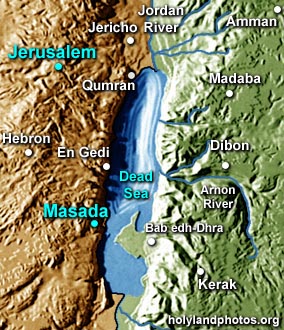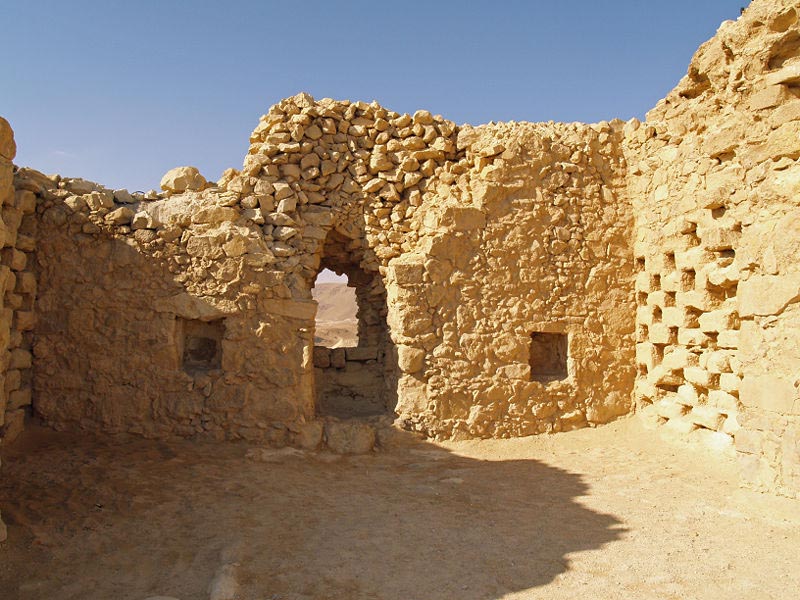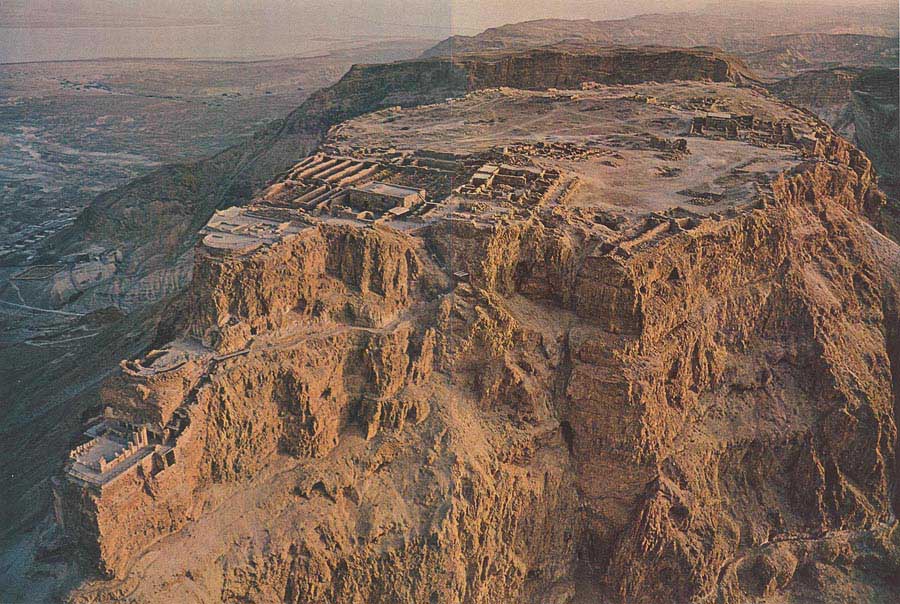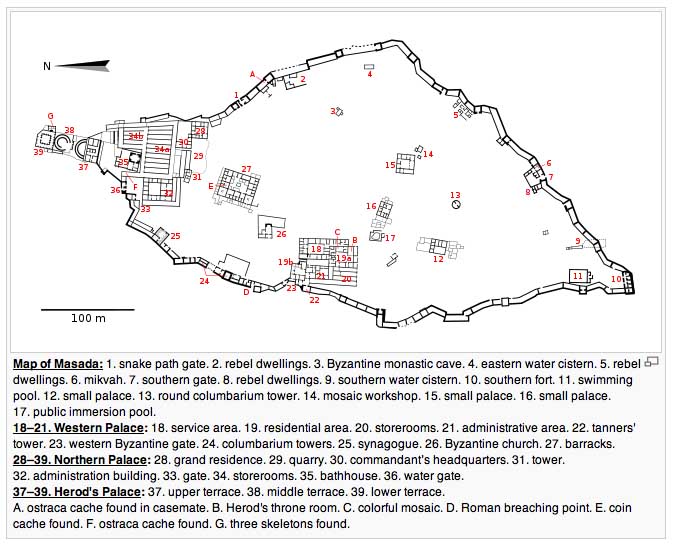



Masada is a mountain top fortress located in Israel on the western shore of the Dead Sea. The name Masada is derived from the Hebrew word "metzude", which means "the mountain castle" or the "stronghold". At Masada's top are the remains of elaborate buildings built by Herod the Great during his reign in the first century BC.

The cliffs on the east edge of Masada are about 1,300 feet (400 m) high and the cliffs on the west are about 300 feet (91 m) high; the natural approaches to the cliff top are very difficult. The top of the plateau is flat and rhomboid-shaped, about 1,800 feet (550 m) by 900 feet (270 m). There was a casemate wall around the top of the plateau totaling 4,300 feet (1.3 km) long and 12 feet (3.7 m) high, with many towers, and the fortress included storehouses, barracks, an armory, the palace, and cisterns that were refilled by rainwater. Three narrow, winding paths led from below up to fortified gates.


Masada is a symbol of freedom and courage to Jews because of its history, specifically the events of the Jewish revolt against Rome in the first century AD recorded by Josephus, when the Zealots held out against Rome for three years at Masada before choosing mass suicide over surrender. Today, Masada is a popular tourist attraction because of its intriguing structures, beautiful view, and mysterious history.
Masada is situated on the top of an isolated rock on the edge of the Judean Desert and the Dead Sea Valley, about 25 km south of En Gedi. It is directly opposite Mt. Moab in Jordan. As a result of its location, the climate at Masada is extremely dry, which has well preserved some of the artifacts. Masada is a diamond shaped plateau and is 1,900 feet long and 650 feet wide, covering a total of 23 acres. Masada rises 1,300 feet above the Dead Sea. The top of Masada can only be reached by two natural approaches: a "snake path" on the east face and the "White Rock" path on the west face.
The only significant historical sources of information about Masada are the writings of Josephus: The Jewish Wars, written between 75-79 AD, and The Jewish Antiquities, written in 93-94 AD. Josephus relates that Masada was first fortified by the high priest Jonathan. The identity of Jonathan has been attributed to either the brother of Judah Maccabee, living in the mid second century BC, or more likely to Alexander Jannaeus, living in 103-76 BC. The only archaeological evidence from this period are some coins dating back to Alexander Jannaeus and plaster from some of the cisterns that dates to this time.
The second occupant of Masada was Herod the Great. In 40 BC Herod fled from Jerusalem to Masada with his family in order to escape from Mattathias Antigonus, who had been made king by the Parthians.
Herod left his family, his brother Joseph, and 800 men at Masada to defend it against a siege made by Antigonus. According to Josephus, the defenders almost died of dehydration but were saved by a sudden rainstorm that filled the creeks and pits on the summit of the rock.
Upon Herod's return from Rome, he raised the siege and rescued his family.
After this incident, Herod transformed Masada into a luxurious fortress. According to Josephus, "Herod furnished this fortress as a refuge for himself, suspecting a twofold of danger: peril on the one hand from the Jewish people, lest they should depose him and restore their former dynasty to power; the greater and more serious from Cleopatra, queen of Egypt".
Herod's construction of this fort apparently took place between 37 and 31 BC. The buildings erected included two beautiful palaces, Roman style bathhouses, administrative buildings, villas, and defensive structures. Masada's summit was enclosed within a casemate wall that was about 13,000 m long, and which contained 30 defensive towers, 70 rooms, and four decorated gates. Herod's most remarkable construction project was the advanced water system built to sustain the needs of the fortress. Twelve cisterns, each with a capacity of up to 140,000 cubic feet, were cut into the rock.
Two dams held rainwater from the two wadis west of Masada, and open plastered channels carried water from these dams to the cisterns. Josephus described Masada's water supply as "in quantity no less than that of those who had springs at their disposal".
After Herod's death in 4 BC, a Roman garrison most likely occupied Masada until 66 AD. During the first Jewish Revolt, Manahem, son of Judah the Galilean, led a group of Zealots in an attack that captured Masada. During the Jewish Revolt, Masada served as a refuge for the Zealots and other Jews and their families until its fall in 74 AD.
The Zealots reused Herod's buildings, modifying them to set up the facilities they needed to serve the nearly 1,000 people that lived on the rock. Two ritual baths and a synagogue were constructed. This synagogue is the oldest synagogue discovered in Israel and the only one dating from the Second Temple period.
In 70 AD, the Romans crushed the Jewish revolt, conquering Jerusalem and destroying the temple. It took three more years to destroy the last Jewish resistance at Masada. Roman General Flavius Silva marched on Masada with 10,000 soldiers. Silva surrounded the base of the rock with a siege wall to prevent any attempts of escape. In addition, eight base camps were established for the army.
Silva's army then constructed a gigantic assault ramp on the western face of the rock, which came to 150 m below the casemate wall. On top of this ramp, a siege tower was erected from which the fortress was attacked with flaming torches, missile-throwing machines called ballistae, and a battering ram.
Josephus described the dramatic last hours of Masada, including Eleazar's speech to the Jewish defenders and the mass suicide of 960 men, women, and children. By lot ten men were chosen to kill all the others. Then among those ten, one was chosen to kill the other nine, set fire to the palace, and then kill himself. This tragic tale was preserved and told to Josephus by two women who survived by hiding with five children in the underground aqueducts.
The only other inhabitants of Masada were a group of Byzantine monks that established themselves there in the fifth or sixth century AD. After this, the location of Masada was forgotten, and it was not correctly identified until 1838 by two American travelers.
Various explorers continued to make discoveries at Masada until the 1960s, when the first complete, organized archaeological expedition took place under the leadership of Yigael Yadin and the direction of the Hebrew University of Jerusalem, the Israel Exploration Society, and the Department of Antiquity of the Ministry of Education and Culture.
The symbol of the Jewish freedom fighters with their families choosing death over enslavement to the Romans continues today to be a legend very much alive in the identity of the Jews. Israeli school children learn about and visit the site as part of their curriculum. Until recently, new members of the Israeli Defense Force were sworn in atop Masada. Today the beautiful remains of the Herodian structures and the haunting ruins of the Roman camps and siege ramps, as well as the symbol of fierce determination and courage embodied in the slogan "never again", draw tourists to Masada's mighty form.
The site of Masada was identified in 1842 and extensively excavated between 1963 and 1965 by an expedition led by Israeli archeologist Yigael Yadin. While a hike up the Snake Path on the eastern side of the mountain (access via the Dead Sea Highway) is considered part of the "Masada experience," a cable car operates at the site for those who wish to avoid the physical exertion. Due to the remoteness from human habitation and its arid environment, the site has remained largely untouched by humans or nature during the past two millennia.
The Roman ramp still stands on the western side and can be climbed on foot. Many of the ancient buildings have been restored from their remains, as have the wall-paintings of Herod's two main palaces, and the Roman-style bathhouses that he built. The synagogue, storehouses, and houses of the Jewish rebels have also been identified and restored.
The meter-high wall that the Romans built around Masada can be seen, together with eleven barracks for the Roman soldiers just outside this wall. Water cisterns two-thirds of the way up the cliff drain the nearby wadis by an elaborate system of channels, which explains how the rebels managed to conserve enough water for such a long time.
Inside the synagogue, an ostracon bearing the inscription me'aser cohen (tithe for the priest) was found, as were fragments of two scrolls; parts of Deuteronomy 33Ð34 and parts of Ezekiel 35Ð38 (including the vision of the "dry bones"), found hidden in pits dug under the floor of a small room built inside the synagogue. In other loci fragments were found of the books of Genesis, Leviticus, Psalms, and Sirach, as well as of the Songs of the Sabbath Sacrifice.
In the area in front of the northern palace, eleven small ostraca were recovered, each bearing a single name. One reads "ben Yair" and could be short for Eleazar ben Ya'ir, the commander of the fortress. It has been suggested that the other ten names are those of the men chosen by lot to kill the others and then themselves, as recounted by Josephus
Archaeologist Yigael Yadin's excavations uncovered the skeletal remains of 28 people at Masada. The remains of a male 20Ð22 years of age, a female 17Ð18 and a child approximately 12 years old were found in the palace. The remains of two men and a full head of hair with braids belonging to a woman were also found in the bath house. Forensic analysis showed the hair had been cut from the woman's head with a sharp instrument while she was still alive (a Jewish practice for captured women) while the braids indicated that she was married. Based on the evidence, anthropologist Joe Zias believes the remains may have been Romans whom the rebels captured when they seized the garrison.
The remains of 25 people were found in a cave at the base of the cliff. Carbon dating of textiles found with the remains in the cave indicate they are contemporaneous with the period of the Revolt and it is believed that as they were buried with pig bones (a Roman practice); this indicates that the remains may belong to Romans who garrisoned Masada after its recapture. Others, nevertheless, still maintain that the remains are those of the Jewish Zealots who committed suicide during the siege of Masada, and all were reburied at Masada with full military honors on July 7, 1969.
The remnants of a Byzantine church dating from the 5th and 6th centuries have also been excavated on the top of Masada.
The Masada story was the inspiration for the "Masada plan" devised by the British during the Mandate era. The plan was to man defensive positions on Mount Carmel with Palmach fighters, in order to stop Erwin Rommel's expected drive through the region in 1942. The plan was abandoned following Rommel's defeat at El Alamein.
The Chief of Staff of the Israel Defence Forces (IDF), Moshe Dayan, initiated the practice of holding the swearing-in ceremony of soldiers who have completed their Tironut (IDF basic training) on top of Masada. The ceremony ends with the declaration: "Masada shall not fall again." The soldiers climb the Snake Path at night and are sworn in with torches lighting the background.
Masada was declared a UNESCO World Heritage Site in 2001. An audiovisual light show is presented nightly on the western side of the mountain (access by car from the Arad road or by foot, down the mountain via the Roman ramp path).
In 2007, a new museum opened at the site in which archeological findings are displayed in a theatrical setting.
A 2,000-year-old seed discovered during archaeological excavations in the early 1960s was successfully germinated into a date plant. At the time it was the oldest known germination, remaining so until a new record was set in 2012. Masada